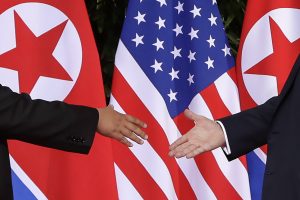The most highly anticipated summit in recent world history came and went. US President Donald Trump met North Korean leader Kim Jong-un at the Capella hotel on Singapore’s secluded island of Sentosa, producing a two-page agreement addressing the long-troubled US-North Korea bilateral relationship and all its attendant issues, denuclearisation included.
It’s true that by sitting across from Kim, Trump accomplished something no other US president before him had. But it’s not true that his predecessors couldn’t have entered a summit with Kim’s father or grandfather had they chosen to. For North Korea, the summit alone was a prize to be won – that’s why other administrations had held out the prospect of a meeting with a US president as a reward for the good faith implementation of successive agreements on denuclearization.
As Wednesday morning’s issue of Rodong Sinmun, North Korea’s internally focused state newspaper, illustrated, the summit was a major propaganda coup for Kim. It emphasized to Pyongyang’s elite and ordinary citizens alike that his byungjin agenda, of pursuing the simultaneous development of nuclear weapons and the economy, had yielded results.
Even while buckling under the US administration’s “maximum pressure” policy of energetic sanctions expansion and implementation – a policy that is now dead in the water after the summit – Kim was able to complete a sufficiently credible nuclear deterrent to force the United States to the negotiating table. And now Kim has his front-page splash on Rodong Sinmun, showing him sitting and standing right beside Trump, the president of the United States, as the leader of a fellow nuclear weapons state.
Several observers in the US have expressed concerns that the summit will legitimize the odious Kim regime – the world’s foremost pariah state, responsible for the operation of unconscionable gulags, currency counterfeiting, cyber theft, and even the manufacture of methamphetamines. But that was always going to be the case, sooner or later.
The problem with the summit ultimately wasn’t the optics or the legitimisation of the regime, though these are certainly points that count against the US ledger of concessions. Rather, the problem was just how little the United States managed to extract from North Korea and how much it gave up.
Denuclearization or the “complete, verifiable, and irreversible dismantlement” of North Korea’s nuclear weapons – long the hallowed and increasingly unrealistic US objective – was present only in name. The summit declaration adopted the language seen in this year’s April 27 inter-Korean Panmunjom declaration. North Korea pledged to work toward the “complete denuclearization of the Korean Peninsula”.
North Korea showed that it maintained its classic interpretation of the phrase, with the state-run Korean Central News Agency noting on Wednesday morning that the language in the Singapore declaration meant that Trump and Kim had agreed “that it is important to abide by the principle of step-by-step and simultaneous action in achieving peace, stability and denuclearization of the Korean Peninsula”. That is a far cry from what the United States understands or expects when thinking about North Korea’s disarmament.
Finally, the “Trump moment” – the unscripted eruption of dangerous uncertainty – came with the president’s comments following his meeting with Kim. Trump said that US exercises with South Korea would be cancelled, because they were “provocative”. The Korean Central News Agency welcomed that decision and use that very same word – provocative – to describe these exercises.
Trump’s decision serves Kim’s long-standing objective of driving a wedge between the United States and South Korea well; the South Korean Blue House and military leadership both have communicated that they had to further examine Trump’s comments, indicating that the move was unexpected and sudden.
But the big picture – a disappointing outcome in Singapore for the United States – was only to be expected. Even with expert US negotiators coming to the table with their North Korean counterparts at the last minute, there likely wasn’t enough time for the two sides to hammer out the necessary details to produce a more comprehensive agreement – one that would venture past the surface of the differences that remain between North Korea and the United States.
The one silver lining is that the summit result will not immediately raise temperatures on the peninsula. To the contrary, the conciliatory US moves will enable and accelerate the implementation of inter-Korean peace. But Washington and Pyongyang are endeavoring to sustain a process of high-level talks; that introduces ample room for differences to emerge and for the present diplomatic bonhomie to fall apart. Keeping up a productive process will require the sustained involvement of experts, sober diplomacy, and, above all, time.
This article first appeared at the South China Morning Post. It is republished here with kind permission.
































